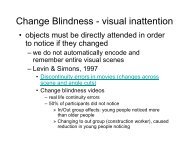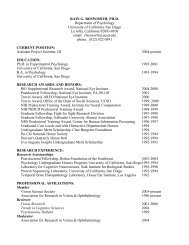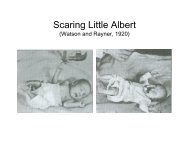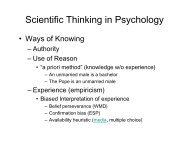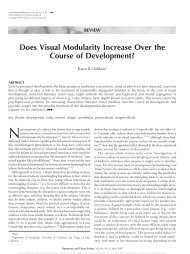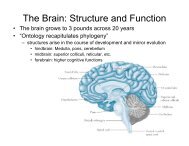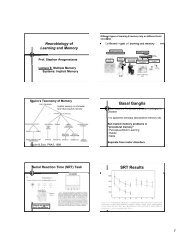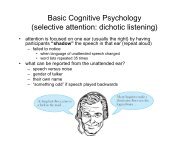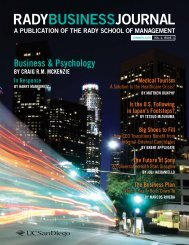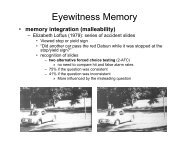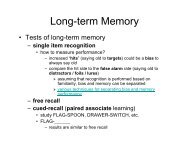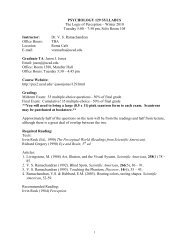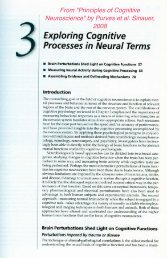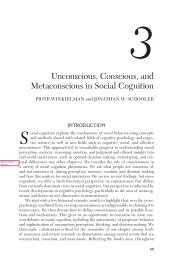For Peer Review Only - Establishing New Traditions
For Peer Review Only - Establishing New Traditions
For Peer Review Only - Establishing New Traditions
You also want an ePaper? Increase the reach of your titles
YUMPU automatically turns print PDFs into web optimized ePapers that Google loves.
Page 3 of 22<br />
1<br />
2<br />
3<br />
4<br />
5<br />
6<br />
7<br />
8<br />
9<br />
10<br />
11<br />
12<br />
13<br />
14<br />
15<br />
16<br />
17<br />
18<br />
19<br />
20<br />
21<br />
22<br />
23<br />
24<br />
25<br />
26<br />
27<br />
28<br />
29<br />
30<br />
31<br />
32<br />
33<br />
34<br />
35<br />
36<br />
37<br />
38<br />
39<br />
40<br />
41<br />
42<br />
43<br />
44<br />
45<br />
46<br />
47<br />
48<br />
49<br />
50<br />
51<br />
52<br />
53<br />
54<br />
55<br />
56<br />
57<br />
58<br />
59<br />
60<br />
Introduction<br />
Neurocase<br />
In the 19 th century, Francis Galton observed that a certain proportion of the general<br />
population who were otherwise normal had a condition he dubbed “synesthesia”; a sensory<br />
stimulus presented through one modality spontaneously evoked a sensation in an unrelated<br />
<strong>For</strong> <strong>Peer</strong> <strong>Review</strong> <strong>Only</strong><br />
modality (Galton, 1883). <strong>For</strong> example, an individual may experience a specific color for every<br />
given note, or every grapheme (printed number or letter) may be tinged with a specific hue (e.g.<br />
C-sharp or the number 5 evoking red). Although synesthetic experiences were long disregarded<br />
as a rare curiosity, there has been a tremendous resurgence of interest in the last decade (e.g.<br />
Ramachandran & Hubbard, 2001a; Ramachandran & Hubbard, 2003a; Mattingley, Rich,<br />
Yelland, Bradshaw, 2001). Furthermore, this research has demonstrated that the phenomenon is<br />
relatively common (2-4% of the population; Simner et al., 2006), is mediated by genetic factors<br />
(Asher et al., 2009), and can influence aspects of everyday life ranging from memory (Smilek,<br />
Dixon, Cudahy, Merikle, 2002) to creativity (Ward, Thompson-Lake, Ely, Kaminski, 2008).<br />
Several lines of evidence suggest that in most instances of synesthesia, the evoked color<br />
is a sensory experience as opposed to a high-level memory association (e.g. from having used<br />
colored refrigerator magnets as a child). Synesthetically induced colors can lead to perceptual<br />
segregation (Ramachandran & Hubbard, 2001a; Ward, Jonas, Dienes, Seth, 2010), different<br />
portions of a single letter can have multiple colors (Ramachandran & Brang, 2010), and some<br />
color anomalous synesthetes may even see synesthetic colors that are unique from those<br />
experienced in the real world (Martian colors; Ramachandran & Hubbard, 2001b), despite the<br />
absence of the “necessary” cone pigments. Furthermore, synesthetically induced colors can drive<br />
apparent motion (Ramachandran & Azoulai, 2006; Kim, Blake, Palmeri, 2006) and the vividness<br />
of synesthetic colors can vary with eccentricity and field laterality (Brang & Ramachandran,<br />
URL: http:/mc.manuscriptcentral.com/nncs Email: hbc@mail.med.upenn.edu<br />
3



